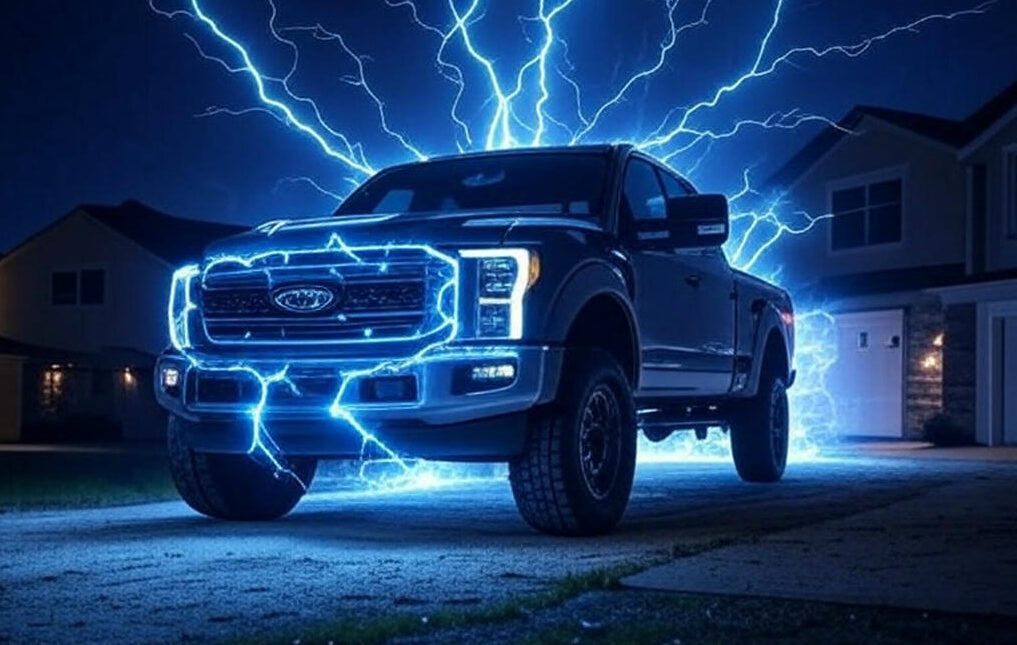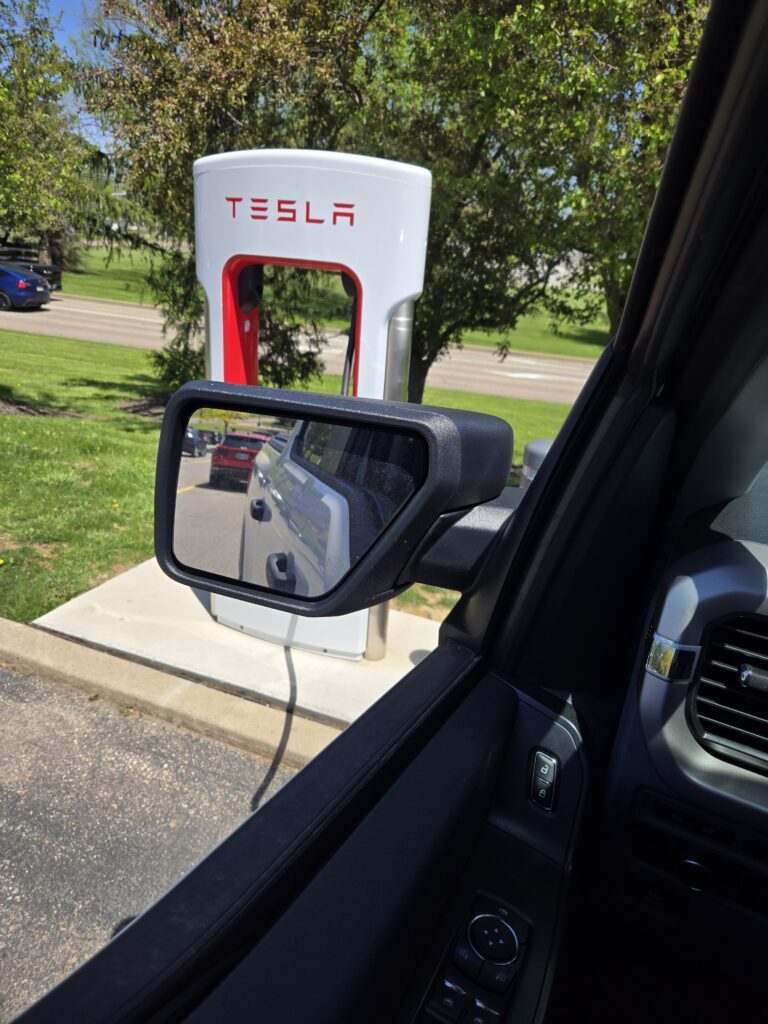
My First Major Power Outage as an EV Owner
- Ian S. Hoover
- 0
- Posted on
Introduction
Owning two electric vehicles (EVs)—a Ford F-150 Lightning and a Tesla Model 3—has been a game-changer for my family. The quiet rides, lower fuel costs, and eco-friendly footprint make EVs a no-brainer. But when a massive storm knocked out power across our area, I faced the ultimate test of EV ownership: a multi-day blackout with two vehicles dependent on electricity. What I expected to be a major inconvenience turned into a showcase of the F-150 Lightning’s versatility and a lesson in preparedness. Here’s how we navigated our first major power outage as EV owners, the challenges we faced, and the surprising ways our vehicles became assets.
The Storm and the Setup
It was a late Tuesday evening when I got home from working late at the office. The power was already out, the result of a fierce storm that had swept through earlier, leaving the sky a mess of lightning and howling wind. My F-150 Lightning, parked in the garage, had a healthy 67% battery (about 160 miles of range). The Honda Prologue, used for a 60+ mile daily commute, was down to 148 miles of range—cutting it close for the next day’s round trip. With no power to our home chargers, I couldn’t top up either vehicle. A utility alert confirmed my fears: a widespread outage with an estimated restoration time of 2–3 days.
For EV owners, a power outage is one of the biggest challenges. Unlike gas vehicles, which can refuel at stations that often have backup generators, EVs rely on a functioning electrical grid or accessible charging infrastructure. With two EVs and no home power, I knew we’d need to get creative.
The F-150 Lightning Saves the Day
One of the standout features of the Ford F-150 Lightning is its Pro Power Onboard system, which turns the truck into a mobile generator with up to 9.6 kW of power output. This feature became our lifeline. Realizing the Honda’s 148 miles of range wouldn’t comfortably cover the next day’s commute, I used the Lightning to charge the Honda. By connecting the Honda to the truck’s 120V outlet (using a compatible adapter), I added about 30 miles of range in seven hours, bringing it to a safer 175+ miles. This was enough to cover the commute with a buffer.
But the Lightning’s utility didn’t stop there. With our home powerless, I used the truck’s 120V outlets to charge our family’s electronics: three smartphones, two laptops, a tablet, and even a couple of portable power banks. By morning, everything was fully charged, and the Lightning still had 55% battery (about 115 miles of range). The ability to power our devices without draining the truck’s driving range was a revelation. According to Ford, the Lightning’s battery can power a home’s critical appliances for up to three days under optimal conditions (Ford F-150 Lightning Pro Power Onboard). In our case, it was more than enough for our immediate needs.
Charging on the Go

By midday, the power was still out, and I needed to run errands. With the Lightning down to 33% (about 76 miles of range) after charging the Honda and our electronics, I decided to hit a Tesla Supercharger station 15 miles away. The F-150 Lightning, equipped with a Tesla-compatible adapter (NACS-to-CCS), charged from 33% to 90% in about 30 minutes, adding roughly 143 miles of range for $26.87. This was cheaper than the $70–90 it would’ve cost to fill a gas-powered truck for similar range, based on average gas prices of $3.50/gallon and 20 MPG. The charging session gave me time to use my phone’s hotspot to catch up on emails, turning a potential inconvenience into a productive break.
If I hadn’t had access to a Tesla Supercharger, I could’ve used an EVgo or ChargePoint station, but the cost would’ve been higher—closer to $0.50/kWh, or about $45 for the same charge. While still competitive with gas in a pinch, the savings at Tesla’s network were a nice bonus. For EV owners, tools like PlugShare (plugshare.com) or ChargeHub (chargehub.com) are invaluable for finding nearby chargers and checking real-time availability, especially during outages when demand spikes.
Missed Opportunities and Future Plans
The outage got me thinking about other ways I could’ve used the F-150 Lightning. For example:
- Powering the Fridge: The Lightning could’ve kept our refrigerator running to prevent food spoilage. With a 15 cu. ft. fridge drawing about 1.5 kWh per day, the truck could theoretically power it for several days. However, with the outage projected to last 2–3 days and the need to keep the truck mobile, I opted not to. For shorter outages (4–10 hours), this would’ve been a no-brainer. The U.S. Department of Energy notes that a fridge can stay cold for about 4 hours without power if unopened (energy.gov), so timing is key.
- Cooking with the Truck: My Pit Boss pellet smoker grill requires electricity, and the Lightning could’ve powered it for a hot dinner. A typical pellet grill uses 300–500 watts, well within the truck’s capacity. I’m planning to try this tonight if the power’s still out—nothing says resilience like grilling steaks during a blackout.
- Mobile Office: My office was also without power, with estimates of 5–7 days for restoration. Local coffee shops and coworking spaces were either packed or powerless. Thankfully, the Lightning became my mobile office. With my phone’s hotspot and the truck’s outlets powering my laptop, I worked comfortably from the cab during a beautiful 65-degree, sunny day. The ability to stay productive on the go was a game-changer.
- Entertainment Ideas: If the outage stretches on, I’m considering using the Lightning for an outdoor movie night. By connecting a projector (200–300 watts) and a small speaker system to the truck, we could stream movies from a laptop or phone. Another idea is a mobile gaming setup—plugging in a Nintendo Switch or a few laptops with a hotspot for multiplayer gaming. The truck’s power capacity makes these fun, morale-boosting activities entirely feasible.
Lessons Learned and Tips for EV Owners
This outage, while initially daunting, made me even happier with my F-150 Lightning. It wasn’t just a vehicle; it was a lifeline. Here are the key takeaways and tips for other EV owners:
- Know Your Vehicle’s Features: The Lightning’s Pro Power Onboard was a lifesaver. If you own an EV with bidirectional charging (like the Lightning, Hyundai Ioniq 5, or Kia EV9), learn how to use it before an emergency. Check your manual or manufacturer’s website for details.
- Invest in Adapters: A Tesla-to-CCS adapter (or vice versa) can expand your charging options. Ford offers a NACS adapter for Lightning owners (ford.com), and third-party options are available on sites like Amazon.
- Plan for Charging Access: Use apps like PlugShare or Tesla’s Find Us map (tesla.com/findus) to locate chargers in advance. During outages, prioritize stations with backup power or those in unaffected areas.
- Conserve Battery: In a pinch, turn off non-essential EV features like climate control, heated seats, or infotainment systems to extend range. For example, Tesla’s “Camp Mode” or Ford’s “Battery Saver” settings can minimize drain.
- Consider Solar or Backup Power: For frequent outages, a portable solar panel or home battery system (like a Tesla Powerwall) can keep your EV charged. The Department of Energy offers resources on solar integration for EVs (energy.gov).
- Stay Informed: Follow your utility company’s outage map or social media for restoration updates. X posts from local users can also provide real-time info on charger availability or road conditions.
Conclusion
What could’ve been a nightmare scenario—two EVs, no home power, and a multi-day outage—turned into a testament to the F-150 Lightning’s capabilities. From charging the Honda to powering our electronics and serving as a mobile office, the truck transformed a crisis into an opportunity. While public charging took some planning, the cost savings and convenience outweighed the hassle. This experience has me more confident than ever in my EVs, but it also underscored the importance of preparedness. For EV owners, a power outage doesn’t have to be a disaster—it can be a chance to shine.
Disclaimer: Always follow manufacturer guidelines when using your EV’s power features to avoid damage or safety risks. Check local regulations for operating mobile power systems during outages.
